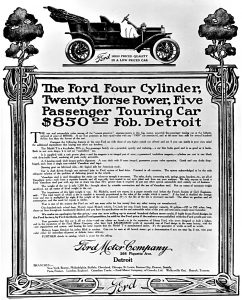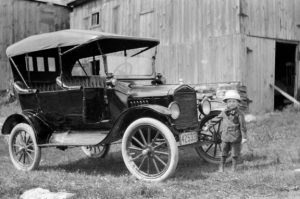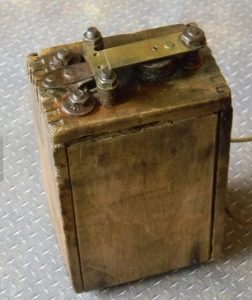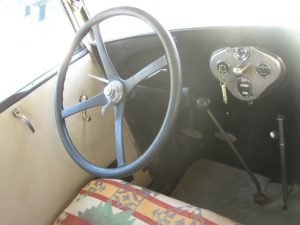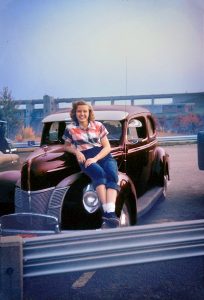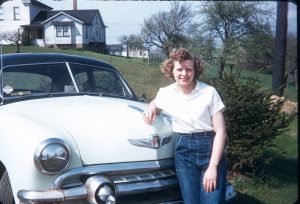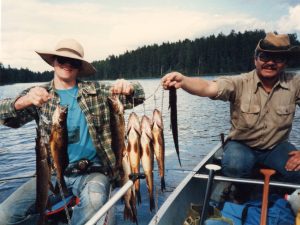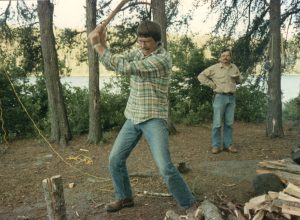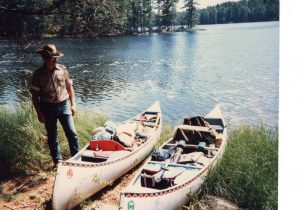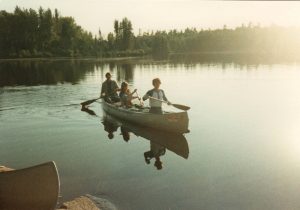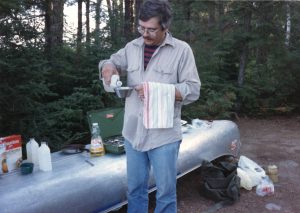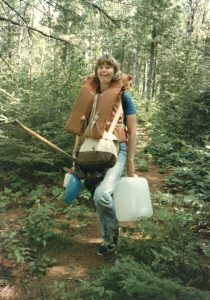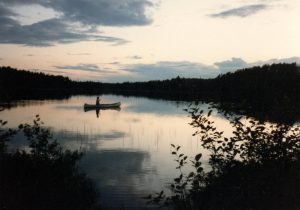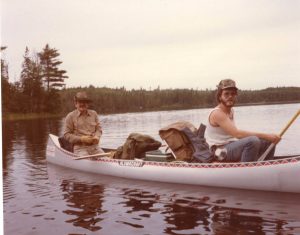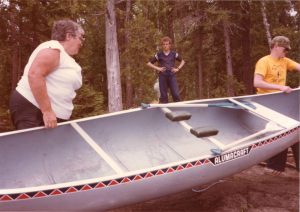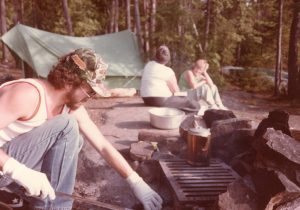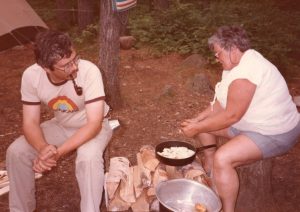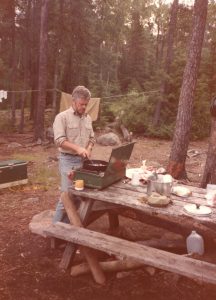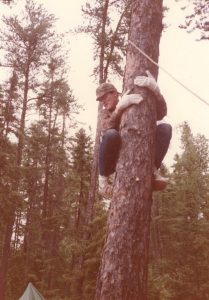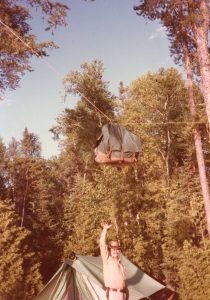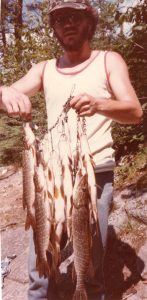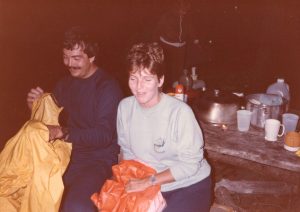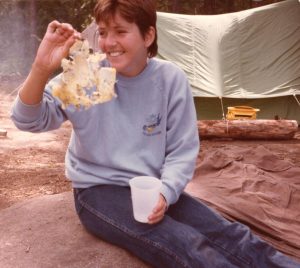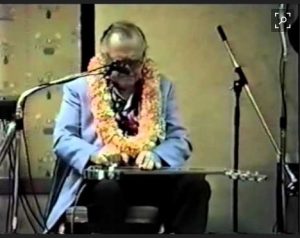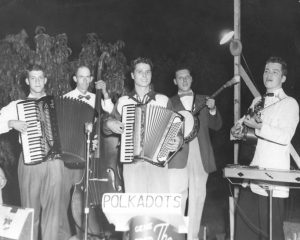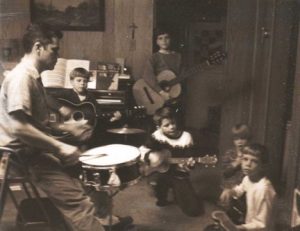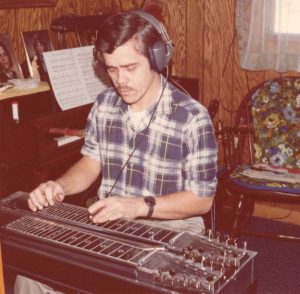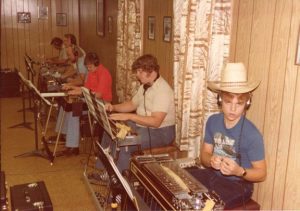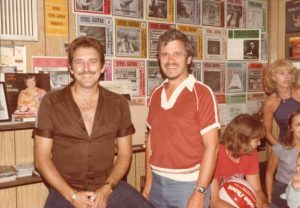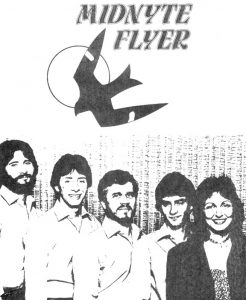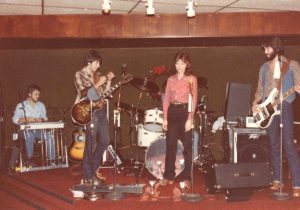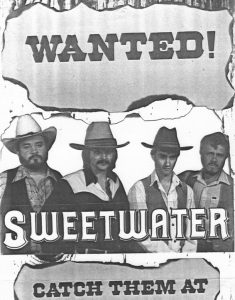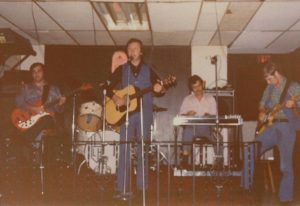The city of Ely Minnesota is the gateway to the western part of the Boundary Waters Canoe Area. It is a charming little town with the usual restaurants, stores, and shops, along with several wilderness outfitters. We used one of these, “Voyageurs North Outfitters”, to furnish canoes and supplies for our wilderness trips.
On one occasion owner John suggested that we might consider a fly-in trip into Quetico, the premier wilderness canoe area of Ontario, and if this was of interest to us, he could make it happen. This definitely was of interest to us, so over the following winter we arranged to make the canoe trip of a lifetime, a fly-in into Quetico.
The planes used were DeHavilland Beavers – beautiful large single-engine monoplanes equipped with floats. These were flown by two somewhat reckless young French Canadian pilots from Quebec who were truck drivers in the winter. They were to fly us and our equipment to Clay Lake, just north of Quetico. All we had to do was paddle through the wilderness and use map and compass to find our way back to Ely, a distance of about 70 miles.

DeHavilland Beavers
My brother Mark wrote an account of this trip in great detail. With his permission I have posted it here.
Following is Mark’s article and some of the pictures taken on this trip. Enjoy.
THE 1987 QUETICO EXPEDITION
by Mark Roliff
Herein is contained the
PETRIFIED TRUTH
regarding the Boundarians’ trip to Quetico
in July 1987
and various
PHILOSOPHICAL OBSERVATIONS
made in the wilds of Southern Ontario.
The purists in the wilderness canoe trip fraternity look on a bush plane with abject disgust. They paddle their Kevlar canoes with carbon fiber laminate paddles, protect their food with bags made of petrochemicals, sleep in vinyl impregnated nylon tents and yet they have the temerity to point at the lowly bush plane and yell, “FIE! It’s an unsightly, high-tech, noise-pollution generator!” Well, get your form-fitted silicone ear plugs ready, boys, ’cause we’re going North the noisy way this time.
Saturday, 11-Jul-87
It was 9:30 PM and I was headed for the rendezvous at Gene’s
house. I was a couple of miles from home when the right side of my
brain knocked on the left side and said,
“You left something at home, Mark.”
“Yeah, Hal, I left a whole hell of a lot of stuff at home.”
“But this is something you wanted to take along on the trip.”
“Nay, nay. I made a list, checked it a blue-billion times, and
checked it again when I loaded the car. Everything’s here.”
“But you are taking a few things that are not on the list. What
about the leather boot laces, and the extra plastic bags, and…”
“Ok, Hal, tell me what it is, and I’ll go back and get it.”
“I don’t know what it is, Mark, but you are going to be really
torqued when you need it and don’t have it.”
“Well either tell me what it is or SHADDAP! If it’s important,
somebody else will have thought of it and brought it. Unimportant
stuff I can do without.”
“But…”
“DRY UP!”
This happens every time I leave on one of these trips. The little guy
is a real pessimist. I wonder how he got that way.
The thought of pessimism made me recall the party we had in the
middle of winter. It was the annual affair where we veterans of
several trips to the Boundary Waters of Northern Minnesota congregate
to view pictures of the last trip and plan the next one. We had just
decided to try a fly-in trip and were counting those who wanted to
join up.
“You in with us, Jim?”
“Welll I dunno. Looks a bit dicey to me. Do you guys have one of
those new survival radios? You know, the kind where you raise the
antenna and throw a switch and the rescue helicopter comes in a couple
of hours.”
“Nope. Don’t think so. Anybody? Uh-uh. Hey, Jim. This isn’t a
polar expedition.”
“Yeah, but what if somebody breaks a leg or has a coronary or
something?”
“If you break your leg, we splint it and schlepp your butt out of
there. You get a coronary, an’ you die. Where do you want us to spread
your ashes?”
Unbelieving stare.
“Hey, Dave. If you are on the trip and peg out on us, where do
you want your ashes to go?”
“Umm. Phantom Lake, just South of the East portage. How about
you, ChrisS?”
“Sprinkle me at the cliff edge above Little Crab. It is really
pretty from up there. Pour a bottle of beer on top; that would be
nice. Mind you, if it’s a light beer, I’ll haunt you for the rest of
your very short life. Gene?”
“I can see you guys have a lousy eye for scenery. Don’t know the
first thing about it. Me, I want my ashes stuffed inside a ladies’
riding saddle. It…”
“C’mon, damnit. I’m being serious,” says Jim.
At the end of the trip I would remember this conversation again
and the laughter would sound a little hollow.
I arrived at Gene’s place at 10:00. The rest of the guys began
to straggle in a bit later. By 11:00 we had loaded our gear aboard
Dave’s van and had left for Parma to collect Irene, the only female we
could find with enough gumption to go with us. By midnight, everybody
was aboard and we headed West. The members of the group were, ChrisR,
ChrisS, Dave, Gene, Irene, and Mark.
Sunday, 12-Jul-87
Everybody took a turn driving. This made light work of the trip.
When not driving, we either slept or “cracked wise”. Dave warned us to
lay off the Polish jokes, as Irene hails from Poland and can’t seem to
get the humor in them. This kept the fun-meter’s needle off the peg
until ChrisS hit on the idea of substituting the words, “Kent State girl”
for “Stosh” in the jokes. That pegged the meter again and all were
content (except for Irene).
Monday, 13-Jul-87
We arrived in Ely, Minnesota between 3:00 and 4:00 pm. The
outfitter confirmed our flight reservations for 10:00 am. the
following day and rented us three canoes, two #3 Duluth packs, a four-
man tent and a leech motel.* In downtown Ely we ate at the Cranberry Restaurant. Knowing this was going to be my second-last civilized meal for the next ten days, I ordered a steak, salad, french fries and a Molson. I thoroughly enjoyed every bite. Then I realized how decadent that was and enjoyed it even more.
That night, we camped in the public campground on Fall Lake. This
allowed us to test the rented tent, load the Duluth packs with food,
and shake down the rest of the gear. The campground was nearly
deserted; a strange turn of events for this time of the year. The
reason for this was discovered later; all the flush toilets were down
for repairs, leaving only the “hole-in-one” variety. After the next
ten days in the wilderness, these facilities would look lavish indeed.
*An insulated box for live fish bait
Tuesday, 14-Jul-87
This morning we ate at “Our Mom’s Restaurant” in Ely. Our Mom’s is
an old frame house with a lot of tables and chairs in the living and
dining rooms. The cash register is in the hall and the rest room is in
the hall closet. There is no sign on the rest room; you just know,
without knowing how you know, that that is where Our Mom would put the
crapper — out there opposite the cash register. Our Mom’s is strictly
a breakfast joint. Ham and eggs and flapjacks are the belly timber she
provides in hot, delicious quantity. The specialty of the house is a
large hot cinnamon roll, carameled or frosted, your choice.
The outfitter had a van topped with three new 17 ft. Grumman
canoes waiting for us. We selected paddles and life vests, loaded some
live bait, and headed for the lake on the outskirts of town. The bush
planes (two De Havilland Beavers) were already moored at the lake side
dock. The pilots were talking to the U.S. Customs agent. One of the
pilots was overheard to say, “I really do have a pilot’s license, but
it is in the wallet that I lost.” When Gene heard that, he wanted to
go home. The pilots spent about an hour trying to tie the canoes to
the pontoon struts. It appeared that they had never done this before.
The outfitter’s lackey had to show them how to make the ropes tight
enough with a slip knot and a half-hitch. Gene saw this and wanted to
go home again.

The Pilots
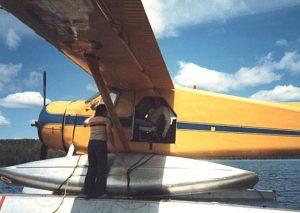
The canoes were lashed to the pontoons
By 11:30 we were ready to depart. Gene, ChrisR and ChrisS boarded
the orange plane. This plane had two canoes tied to the struts and
carried the lightest baggage. Dave, Irene, and I boarded the yellow
plane which carried one canoe and the heavy stuff. I was amazed at how
quickly the plane left the water. The pilot pushed the throttle
forward about a third of the way, adjusted the propeller pitch, looked
out the window, pulled back on the stick, and we roared up into the
sky. Then he fiddled with the fuel mixture and some thumb wheels on
the ceiling and began to study his map. Our destination was the
Canadian Customs Station at Cache Bay. The ride was noisy and the
plane behaved as if it wanted to fly sideways. I think the single
canoe roped to the port struts made the plane yaw a little.
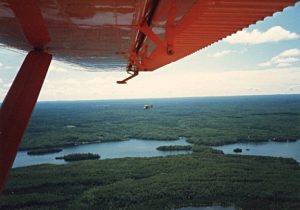
We landed at Cache Bay and the pilots moored both planes to the
customs station’s dock. Gene walked up to the customs office to
answer the obligatory questions. I followed him a few minutes later,
thinking that everybody was going to be grilled. I wanted to get it
over with. An old man in a uniform was sitting at a desk, asking Gene
a series of loaded questions and trying to look intimidating.
Colonel Chop-Sausage: “Did you bring any liquor?”
Gene: “Yes.”
Colonel Chop-Sausage: “How much?”
Gene: “Thirty ounces apiece.” (forty ounces is the limit.)
Colonel Chop-Sausage: “Did you bring any beer?” (meaning, “Do you have
any cans?” -forbidden fruit in Quetico)
Gene: “No beer.”
Colonel Chop-Sausage: “Did you bring any wine?” (meaning, “Do you have
any bottles?” -also verboten)
Gene: “No wine.”
That was it. Having been shriven and sanctified, we were free to
camp in Quetico, but we could not yet fish. In order to fish, one’s wallet must be purified. If you start with a pure wallet (one untainted by filthy lucre) it won’t answer. You must start with a purse defiled by large quantities of the oil of Saint John Goldbeard and have it made clean again by an official anointed for that purpose. Moreover, the Anointed One does not reside at the customs outpost. We had to get back into the planes and taxi a quarter mile to a fishing lodge where the rites of purification are performed.
The dock at the lodge had room to moor only one plane. Our pilot
taxied out into the bay, cut the engine, and we drifted while the
other party bought fishing licenses. As they were climbing back into
their plane, the other pilot yelled out to us,”I want to fly on ahead. Do you think you can find the lake?” Our pilot looked at his map for a minute and shouted back, “Uh, yeah…I think so.”
This time, I wanted to go home.
The other plane buzzed down the bay and took off. Our pilot
started the engine, began a wide, sweeping turn to the right, and
studied his map some more. I noticed that we were turning toward a
canoe with two women in it. They looked at us with vacuous grins. They
had quit paddling.
“Gee, Alice! Look at the pretty yellow airplane.”
“Yeah, Gertrude, I wonder if that propeller will cut us into fish
bait.”
“Let’s wait here and find out.”
I slapped the pilot’s shoulder and pointed. He made a cut to the left and missed the canoe. He said, “Thanks, I didn’t even see them.”
The women continued grinning. I wanted to go home.

We purchased our fishing licenses at the lodge and took off
again. Our air speed was 110 mph. and we flew at an altitude of 1500
ft.
As the plane circled Clay Lake, I could see the Greenwood River.
It is the lake’s outlet and was the first stretch of water to be
traversed on our trek back to civilization. It looked like a real
bummer; shallow and meandering, with trees fallen across the channel.
It was no wider than a small creek.
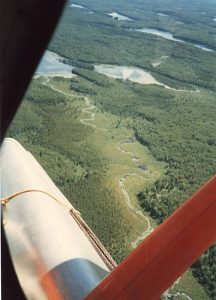
The Greenwood River
The pilot landed the plane on the water and we unloaded from the
pontoons. There was no dock on the edge of this lake. I boarded a
canoe with ChrisS. ChrisS and I would be canoe partners for the whole trip.
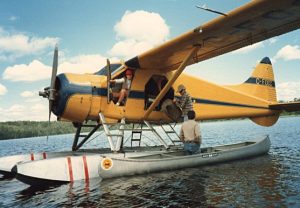
Unloading in the middle of the lake was a real balancing act
The plane taxied down the lake and took off. The pilot circled
the lake below the tree line. Suddenly, he topped the trees to the
west and, gunning the engine, buzzed us, wagging the wings in
farewell.
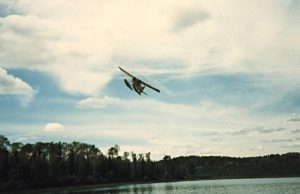
The earth shuddered, then all was silent
We were alone in the wilderness, approximately sixty miles from
civilization. The only way out was a chain of lakes, rivers and
portages. We were certainly in a wild place, but it didn’t look
menacing. That could definitely be changed by an injury, a badly holed
canoe, or by a bear grabbing our food. I was determined to keep a
sharp eye on the maps and not do anything stupid.
I told the rest of the group what I had seen of the lake’s outlet
from the air. A decision had to be made whether to camp on the lake
shore or try to reach the camp at the rapids halfway down the Wawiag
River. The outfitter told us to camp at the lake if we arrived after
2:30. It was 2:30. We decided to “scout” the Greenwood River for a
short distance and then make the decision to return or press on.
The Greenwood was narrow and meandered through a large swamp.
Some of the curves were so sharp and the creek so narrow that we had
difficulty maneuvering the canoe through them. The water was very
shallow and we had to stop often and get out of the canoes and pull
them through mud and over sand bars and deadfalls. The outfitter
mentioned a “few pullovers”; he must have seen this territory when the
water was higher. After an hour of paddling and dragging those canoes
through the mud and deer flies, nobody wanted to return to the lake.
Thus, our “scouting” expedition turned into the actual start of our Quetico canoe trip.
Each canoe took a turn in the lead position so each pair of
paddlers could get “first squint” at the wildlife encountered on the
shores. The changes were usually made when traffic piled up at a
deadfall. Once, when Gene and ChrisR were in the lead, they rounded a
bend and came face to face with a moose. The creature was standing in
the stream eating water plants (moose moss?). It looked at the two
canoe jockeys and walked up the bank toward the tall weeds. By the
time I arrived on the scene, all that was visible was Bullwinkle’s
arse disappearing into the brush.
After several miles of this paddle-and-drag locomotion we finally
arrived at the Greenwood’s junction with the Wawiag River. The Wawiag
is about thirty feet wide and is deep and black. Its banks are so
regular, the river reminded me of a canal. We stopped at the junction
and took time out for a good squint at the map. The river had no
visible current at this place, and a wrong turn here would have put us
“up the Wawiag” for sure.
Everyone agreed it was time for a snack so we passed around bags
of gorp and jerky. Irene gnawed off a bite of jerky and said,
“You make all the jerky, Mark?”
“Yup.”
“This looks different from what we tried last night. Kinda black.
Different recipe?”
“Uh…oh, yeah. Different recipe.”
She shifted the food to her cheek and said with exaggerated
patience, “Alright. What is it?”
“Bambi.”
“Huh?”
“Venison. White-tailed deer. ChrisR shot it last fall.”
“Oooh,” she wailed, then took a couple of tentative chews and
said, “Hey! Bambi is GOOD!”
This river meanders its way through a swamp toward Lake Kawnipi.
The banks were regularly dotted with beaver lodges whose inhabitants
slapped the water in alarm as we paddled into sight. Once, when we
stopped to rest, I spotted a graceful plant growing in the mud. It
had feathery leaves and white flowers growing in umbels, quite similar
to a wild carrot. Dave produced a field guide for plants and
identified the plant as water hemlock, possibly the most poisonous
herb in the northern hemisphere. Once the identification was made, we
found it growing all along the river banks.
Rounding a bend in the stream, we came upon two moose browsing on
the bank. The bull immediately walked into the brush. The cow watched
us for a while and walked off into the weeds as we drifted near.
We decided that we could not make our objective (the portage at
the rapids) before nightfall, so we looked around for a possible
campsite. The first feasible place lay on a bit of high ground where
Mack Creek joins the river from the south. Here it was necessary to
kneel in the bow of the canoe and chop a path through dead brush and
floating branches to the shore. The site was a jumble of fallen and
rotting, moss-covered trees. Most of the ground was uneven and
unsuitable for pitching tents. We spent about a half hour
reconnoitering and found suitable places for the tents, a place for a
campfire, trees for bear ropes, etc.
“Hey, up there! Hey!”
I was interrupted by the little demon who lives in my medulla.
He’s in charge of the housekeeping chores. He inflates the lungs,
pumps the heart, makes the kidneys distill, things like that. He has
the mentality and disposition of a lizard. His name is Grinulf.
“Yeah, Grinulf, what is it?”
I’m cold, I’m hungry and my shoulders are tired. Do something
about it. Today, dammit. Today!”
“I’m going for dry shoes and socks now, Grinulf. You’ll have to
wait for hot food until we light a fire. How about some gorp in the
meantime?”
“Bag the gorp! I’m tired of chewing jerky and grinding gorp. And
just look at this place. Am I going to sleep here? The ground is
covered with moose marbles!”
“Moose marbles are softer than roots and rocks. Besides, remember
Italy, back in 1970 when we camped in the field covered with liquid
pig manure? Count your blessings.”
“I can’t count that high!”
I have to parry Gene’s backhanded witticisms, mug for Dave’s
camera, and endure ChrisS’s disgusting puns. Now my lizard is making
sarcastic cracks. Why did I join this itinerant asylum, anyway?
Gene and I put up the bear ropes while the others pitched tents
and gathered firewood. Supper was Ramen noodles, fruit, and hot
chocolate laced with rum. By 10:30 it was bag time and we turned in,
tired and muddy, on the banks of the wild, silent Wawiag.
Wednesday, 15-Jul-87
I unarsed the tent at about 8:00 am. My head was a bit stuffy and
my throat was a little sore. I probably inhaled a snootful of pollen
and breathed against a tonsil all night. That would do it.
It was time to light a breakfast fire. The others awoke, poking
tousled heads from their tents as I broke sticks and raised general
bedlam in camp. (The first one up generally doesn’t cut the lay-abeds
any slack.) Breakfast was a cup of hot chocolate mixed with a double
handful of granola. If you let this mixture stand a little while, it
thickens up and the flavors mingle better. It is a lot more
interesting than plain “old roats”. During breakfast, Irene and ChrisR
casually mentioned that their throats were sore also. Nobody felt
sick, however, so we ignored the discomfort and pressed on.
We broke camp, sponged the mud out of the canoes, and continued
down the river. In our travels that day we paddled into the territory
of a family of river otters. They hissed and barked at us while Dave
and ChrisS took their pictures. The ruffed grouse were extremely tame in this area. One pair allowed us to approach them to within four feet.
A 2.5 hour paddle brought us to the rapids. Here was a twenty rod
portage with a campsite at each end. Camp was made at the downstream
end of the portage. Gene and I filtered water while ChrisR and Dave
fished the pools and eddies in the rapids. The fishermen had good
luck; there would be northern pike and walleye for supper.
The fried fish were eaten with beef stroganoff which the cook
extended with extra noodles. Everyone agreed that camping doesn’t get
any better than this. In the evening, cocktails were made with Wyler’s
wild cherry drink laced with rum. This mixture would taste better if
it didn’t remind the drinker of watered-down cough medicine.
At bag-time, the sound of water pouring over the rocks put us to
sleep in short order.
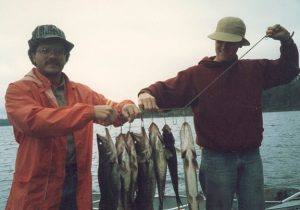
ChrisR and Dave with walleyes and northerns
Thursday, 16-Jul-87
I crawled out of the tent in the morning and zipped the door
shut. When I stood up, the world turned upside down about four times
before I could get back on the ground again. The sore throat was
worse. Time for a war council.
“Hey, Grinulf!”
“Yo.”
“What’s wrong with the gyroscope’s roll gimbals this morning?”
“It’s that case of throat-rodents you’ve come down with. They
have gummed up the inertial platform. It takes more time to spin it up
in the morning.”
“Did you turn out the boys in white yet?”
“Yeah, yesterday already.”
“What’s your assessment, Grinulf? Is somebody going to have to
carry me out of here?”
“Nay, nay. That beer gut you so industriously built up last
winter gives me a lot of reserve. Just don’t make an Olympic event out
of this thing, and we’ll make it with bells on.”
“Give ‘er hell, Grinulf.”
“Keep our butt out of drafts!”
Dave was already up, bustling around the camp. He had the fire
going and was cooking a panful of scrambled eggs. I heard some
wallowing noises coming from up the trail where ChrisS had pitched his
bivy tent. The tent was undulating and bulging as if there was a big
caterpillar inside getting ready to pupate. He could save himself all
that cussing and dratting if he would just dress outside.
We ate the eggs with toasted English muffins and hot chocolate.
Powdered eggs always taste better in the woods than anyplace else.
Maybe Dave has a special recipe. I’m going to watch how he prepares
them next time. After we each had “washed our dish”, we broke camp and paddled the last stretch of the river. ChrisR caught a three pound smallmouth bass near the mouth of a large bay. The wind was kicking up whitecaps on Kawa Bay as we exited the mouth of the river. A three hundred yard paddle through very rough water brought us to a campsite on the North end of the bay. The wind continued all afternoon.
I have never seen fishing like this. The fish are large and
stupid; they seem to bite on anything. Dave and ChrisR could catch
supper for six in about fifteen minutes. (Usually they need a half
hour.)

Naturally, there was a fish fry that evening. Freeze dried
lasagna and tea topped off the bill of fare. For cocktails, we mixed
some of Dave’s Peppermint Schnapps with the wild cherry slosh. This
tasted even more like cough syrup.
That evening, two moose walked out into the shallow bay to the
North of the camp and began to feed. Dave and ChriS took some telephoto
pictures of them and then launched a canoe to try for some close-ups.
The moose heard the first bump of the canoe on the rocks and lit out,
water and mud flying from their hooves as they ran for the shore. They
had vanished into the brush before the canoe was even afloat.
We wanted to continue our journey the next morning. A wake up
call was left with Gene for 5:00 am., thinking the wind would abate
in the early morning. (You might know that some twit would bring an
alarm clock to the wilderness.)
Friday, 17-Jul-87
At 5:00 am. we awoke to the insectile chirp of Gene’s watch.
Gene took one look at the lake and crawled back into his bag. We were
wind bound. It was blowing straight down the length of the bay, right
into our teeth. A thunderstorm blew in after breakfast. The wind
abated after the storm. We took the opportunity and made a break for
it.
Our route took us down the length of Kawa Bay and into the main
body of Lake Kawnipi. We made a short stop at the North shore of the
lake to look at an Indian pictograph. The drawing was found in a
sheltered nook in the granite, about eight feet above the water. It
was red on a brown background and very faded. I could barely make out
a representation of three men in a canoe.
There were two islands with campsites at the North end of McVicar
Bay. The first island we checked was occupied. We paddled by a large
rock upon which perched a mob of little girls dressed in bathing suits
and life jackets. They were cannon-balling into the water, trying to
decide who could squeal the loudest. Egad! I could just envision them,
each with a five million candle-power flashlight, ripping and tearing
through the woods at night, giggling and riding saplings to the
ground. The second island was deserted. Luckily, the best campsite was
out of earshot from our neighbors. Gene and ChrisR caught more fish
for our supper; mostly pike and walleye. Gene, however, brought back
a four to five pound smallmouth bass. He turned it loose after a
photography session. The fish were cleaned on the rocky point of the
island. The scraps were left to the gulls, who cleaned up the place in
short order.

At supper time a large pan of lentils pilaf complimented the fish
fillets. Gene thought some of his gin might tame the wild cherry
mixer. We tried it. I got mine down, but just barely. On previous
trips the portages improved our moral fibre; this year the drinks
would do it. An inquest was held to find out who bought all that wild
cherry mix, but “Brer Fox, he lay low and didn’t say nuthin’.”
Saturday, 18-Jul-87
The wind changed 180 degrees during the night. In the morning it
was blowing out of the Northeast. The sky was heavily overcast and it
rained fitfully throughout the day. Dave and ChrisR went fishing before
breakfast. They brought back a stringer loaded with pike and walleye.
Most of the fish were turned loose after the obligatory photo session.
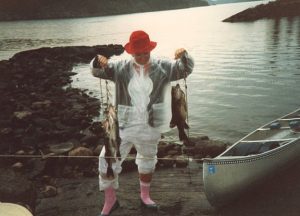
I watched Dave fry the fish for brunch. His culinary engineering
secrets are secrets no longer. He just gets the best ratio of bugs and
bark in the food when he cooks. I kept dark about this discovery. I
bided my time. The next batch of hoppin’ john would be unbelievable.
The day was spent exploring the island and “gathering wool”
around camp. I took a couple of naps; Grinulf needed a free hand in
the war with the “throat-rodents”.
Supper was freeze dried macaroni and cheese.
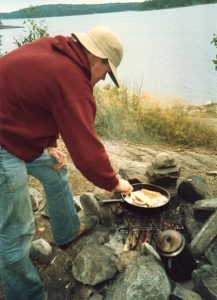
Sunday, 19-Jul-87
We broke camp early and set out to the South, down McVicar Bay.
The sky was overcast and we had frequent rain squalls; sometimes heavy
rain, sometimes a thick mist. An easy 20 rod portage took us to a
small pond. From there an easy 36 rod portage put us in Anubis Lake.
Anubis was breathtaking. Thick streamers of white mist slowly
swirled through the trees and coalesced over the water. The piney tang
in the air and the thin rain sprizzling on the surface of the water
reminded me of a giant gin and tonic in a Jules Verne dream. I reached
for my camera and then thought, “No, I’m not going to share. This one
is for me.”
The 64 rod portage from Anubis to Bird Lake began at a long,
sloping, lichen-covered rock. The wet lichens made the rock very
slippery and treacherous, especially for a man with a canoe on his
back. The rest of the portage was covered with jumbled, slippery rock,
making for extremely dicey footing. It rained like an idiot the whole
time we were on the portage. Everything became damp in spite of all
our rain gear and “waterproof” bags.
Bird looked much like Anubis but the mist was thinner and the
rain at times fell very hard. Sometimes it splashed so high the
surface of the lake became indistinct and we seemed to paddle (and
bail) across a cloud. The cameras stayed in their bags here too.
We crossed Bird to the West of the island at the South end of the
lake. This was a mistake because the river parallel to the portage had
silted up the bay on that side. The water was three inches deep in
places. We paddled through the silt, each stroke making six inches of
headway and leaving a stinking pile of mud on the surface of the
water. Getting stuck in that mess would make a dynamite subject for a
victorian nightmare. The eighty rod portage from Bird Lake was a path
through sharp, slippery rocks. Again, we made the carry in a downpour.
The rest of the day’s trek consisted of an easy paddle up the
Agnes River, ending at a nice camp on an island at the North end of
Agnes Lake. By the time the camp chores were done, it was supper time.
Supper was meant to feature beef stroganoff. However, the beef
stroganoff proved rancid and inedible. A bowl of Ramen noodles was the
highly unsatisfying substitute. The company which made the stroganoff
goes to the top of the black list!
The sky began to clear toward evening. By nightfall the heavens
were empty of clouds and shining with stars. Happy-hour brought more
wild cherry slosh and topped off my day’s already brimming allotment
of moral fibre. We sat on logs around the fire, sipping our cocktails, swapping lies, and easing our “boundary buns” as best we might. Irene borrowed my flashlight for a return to the overturned canoe which served as a bar. She replenished her drink and handed the flashlight back to me.
We missed connection and the light fell on the ground and went out.
Drat! The filament probably broke. I went to my pack for a spare bulb;
the bulbs weren’t there. They weren’t in my floating pouch either.
“Hal, did I leave the spare bulbs behind?”
“I tried to warn you when we left home, Mark.”
“Thanks a lump. You were a big help.”
“Its not my function to be explicit in such matters.”
“Don’t give me the ‘its not my job’ routine, Hal. Now we are
going to be groping around in the dark for the rest of the trip.”
“You said someone else would bring really important things.”
“Your memory is explicit enough now, Hal.”
I mooched a spare bulb from Gene.
Monday, 20-Jul-87
We slept late in the morning. I planned to make a batch of
hoppin’ john for the evening meal. The beans would have to soak while
we were on the move. I poured the beans into a plastic garbage bag,
added a gallon of lake water, tied the bag shut, and stashed the whole
works in one of the Duluth packs.
By the time the chores were done and the canoes loaded, the wind
was blowing at a pretty good clip from the SSW. We slanted our course
toward the shelter of the western shore. In the open, the waves were a
foot high; sometimes higher. The bows of the canoe slammed into the
waves, sending sheets of spray flying to either side. Halfway down the
lake, we cut across to the Eastern branch and found a camp on the West
shore. Here the lake had high granite cliffs and bluffs on both sides.
Our camp lay at the bottom of one of these bluffs.
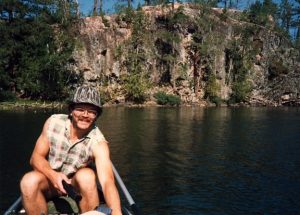
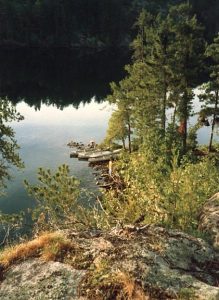
Our camp on Lake Agnes
It was time to fix supper. I put the washed beans in a deep pan,
added a half box of rice, a packet of freeze dried beef, and a handful
of cut up Slim-Jims. A gallon of water and onto the fire she goes. At
the boil, I put in some salt, pepper, dried celery, and (is Dave
watching?) walked away while Mother Nature added the bugs and bark.
The crew liked it. At least they ate it and said they liked it.
At happy hour someone found a packet of lemonade mix. With rum,
gin, or peppermint schnapps, it made the end of a perfect day.
Tuesday, 21-Jul-87
Mid-morning found us on the move again. After paddling a few
miles South, we stopped at Louisa Falls where Lake Louisa empties into
Lake Agnes. The waterfall is about a hundred feet high and splashes
its way down a steep rock slope. Halfway down the slope the water
pours into a natural oval “bathtub” eroded into the rock. It is a
beautiful place with broad vistas of green forest and blue water. The
woods was crawling with groups of boys and their guides.
One of the guides approached me and asked what kind of pipe
tobacco I was smoking. He said he was going to take up pipe smoking in
order to enhance his image as a guide. Gene almost burned out a
bearing, trying not to laugh. He managed it, but today he’s a broken
man. I don’t get no respect.
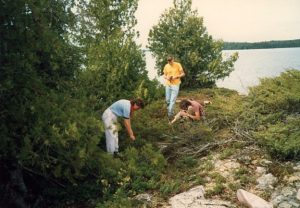
Lake Agnes
The second guide described the next two portages we would
encounter: the 140 rod “Bastard” and the 193 rod “Bitch”.
The “Bastard” began at the South end of Lake Agnes. It was a
middling long portage strewn with rocks. A short paddle after
“Bastard” brought us to the “Bitch”.
“Bitch” was similar to “Bastard”, in that it was rocky. However,
it had a few extra attractions, namely extra length, hills, and muddy
places. This carry put us on the North shore of Sunday Lake.
A three mile paddle down Sunday Lake brought us to the Singing
Brook portage. This portage was a ten rod carry along the brook
through which Sunday Lake empties into Burke Lake. We stopped there to
filter some water. Nearly everyone was nursing his last pint, and
getting pretty parched doing it.
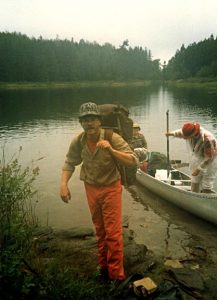
The next portage was on the other side of Burke Lake, a 1.5 mile
paddle from Singing Brook. While paddling by an island in Burke Lake,
we saw a man standing on a high rock overlooking the water. He waved
and said, “Hi!” Irene waved back and asked, “Got any cold pop?” The guy
would not dignify that question with a reply.
The twenty eight rod portage at the South end of Burke Lake took
us to Bayley Bay. This was an easy carry along a level sand and gravel
path. We camped on Bayley Bay at a campsite to the left (East) of the
portage. The bay had a wide sand beach and was very shallow. Fifty
yards from shore, the water was only waist deep.

Bayley Bay
Dave and Irene pitched their tent on the beach. The rest of the
tents were erected under the trees, nearer the fire ring and bear
ropes. The previous campers had left the makings for a fire in the
rock fire ring. Twigs and birch bark were all arranged, ready for a
light. I had to take it all out of there so I could rearrange the
rocks to fit our fire grate. We always tidy up our campsite, and
usually leave some fire wood behind, but tinder and kindling ready to
light is a nice touch.
Supper was Rice-a-Roni and Ramen Noodles. Another packet of
lemonade mix surfaced from the depths of the food pack, making happy
hour an unalloyed pleasure. There was another advantage to this place;
after a week of sitting on logs, stumps, rocks, and aluminum canoe
seats, here we had some nice soft sand to park our “boundary buns” in.
Small pleasures after a long day. The gang sat around the fire,
drinking tepid lemonade laced with various and sundry “ardent spirits”
and brailling down the day’s yield of moral fibre. With this
persistent sore throat, I felt I was getting more than my share. It
was time for an accounting.
“Hey, Grinulf, old snake!”
“Yeah, what is it now?”
“I want a status report. These throat-rodents are beginning to
annoy me. And I spell “ANNOY” with capital letters!”
“The leukocytes had trouble figuring the combination there for a
while. Now they are playing catch-up. It’s gonna take time.”
“They’d better get the lead out, Grinulf. In eight hours I’m
gonna have a nice gargle with some 151 proof rum.”
Happy hour is the only time I can call Grinulf on the carpet and
get away with it.
Later that night the wind kicked up and a rain storm blew in. The
waves made such racket on the beach, I thought Dave and Irene might be
washed out into the bay. Gene went out in the night to make sure the
canoes were beached above the surf.
Wednesday, 22-Jul-87
For breakfast we ate “old roats” cooked in hot chocolate. By that
time the supply of sumptuous viands was running low.
The wind on the bay was moderate, but there was so much fetch to
the South that there was a high swell running. At the outset I
arranged with ChrisS to help steer if the wind caught the canoe and
threatened to broach it. We steered quartering into the West wind,
aiming for the lee of a large island. I gave the tiller to Hal. He has
parallel inputs and dual ported processors which make vector analysis
much easier when protractors and dividers are not available.
The sky was overcast and threatening rain again. A large bird was
soaring over the forest, moving back and forth in the blustery wind.
Was it a buzzard or an eagle?
“Steer, ChrisS!”
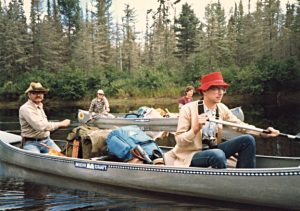
ChrisS, where did you get that awful-looking hat?
The canoe was almost broadside to the waves. ChrisS dug in his
paddle and pried the bow back into the wind.
“What’s going on, Hal? What happened?”
“I’m mortified, Mark. I was watching the eagle and the canoe got
away from me.”
“Pay attention! If ChrisS had not been on his toes, you would be
watching pike right now! Hey, Grinulf.”
“Yo.”
“Turn off the adrenalin spigot before this paddle breaks in
half.”
“Ok, but you guys are wasting your time watching grouse and
eagles. Let’s stalk a more worthwile bird, like a Rosy-Breasted
Mattress Thrasher.”
Jeez, Louise! My lizard is making ribald puns now. I’ve been
paddling a canoe with ChrisS too long.
We paddled through Bayley Bay and South through Birch Lake to
Prairie Portage. This twenty rod portage follows the river where
Sucker Lake empties into Birch. We took time to fill our canteens and
water bag at the Canadian Customs office at the North end of the
portage.
Sucker Lake is the northernmost lake in a long chain. Newfound
Lake is in the center of the chain and Moose Lake is on the South end.
Motor boats are allowed on these lakes and a canoe towing service
plies the water between Moose Lake and Prairie Portage. The tow boats
were large aluminum punts with canoe racks on top.
No tow for us. We are paddlin’, portagin’, pike-eatin’, bad-
weather lovin’, hard arsed denizens of the Boreal Forest! We paddle
the creeks and stare down moose! We dilute our rum with cough syrup! A
tow boat? FIE! Its an unsightly, high-tech, noise polluting mechanical
contrivance so far beneath our dignity that it’s driver must think a
snake’s arse looks like the North Star.
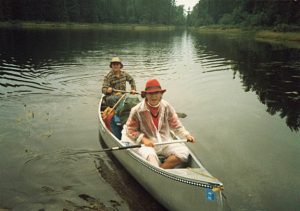
Looks like she got the hat back!
Halfway down Newfound Lake we made our last wilderness camp. Here
was the first Forest Service fire grate and latrine we had seen on the
whole trip. Supper was Ramen noodles (the hors d’oeuvre) with macaroni
and cheese for the main course. Cocktail hour featured rum with wild
cherry slosh.
The sky was overcast with a dull glow of lightning in the west.
We sat around the fire, telling lies and enduring ChrisS’s unspeakably
bad puns until 11:30. The lightning was now closer, bringing with it
the distant mutter of thunder. We prepared for a wet night and turned
in.
I awoke to a hell of a crash. The lightning was nearly
continuous. The strikes were so close we could hear the “click” of the
leader about a half-second before the lightning struck: Snick…BAM!
The thunder claps made the walls of the tent quiver. Rain began to
splash in through the tent’s screen door. ChrisR and I closed the storm
flap. Even in the closed tent, a flashlight’s beam was washed out by
the lightning. Later, I awoke to a continuous and nearly deafening
uproar. Click..spup-snick WHAM BABAM! The bottom of the tent was
floating in the center so that when I pushed down on the floor, waves
radiated outward. ChrisR and I looked at the storm flap we had closed
earlier and water was squirting through the zipper in little streams.
Would we drown before we were electrocuted, or afterward? It is at a
time like this that you begin to think:
“We camped at the bottom of a cliff. Not the place to be in an
electrical storm. Pitched the tent under a tree. We are sleeping on
top of all those nice conductive roots…in a tent with an aluminum
frame. Oooooh wellll.”
I put some plastic bags under the foot of my sleeping bag and
went back to sleep. That was, by far, the most violent storm I had
ever been in.
Thursday, 23-Jul-87
There were five inches of water in the canoes that morning. The
level of the lake was up. Breakfast again brought “old roats” cooked in hot chocolate.
Irene helped Dave dismantle their tent. She found that a mob of
night crawlers had taken shelter under the ground cloth. She delivered
herself of an explosion of opinion; she was “grossed out”.
“Yeah, Irene, think of all those slimy annelids wriggling around
in the mud, less than an inch from you all night.”
(More heartfelt and prolonged expressions of revulsion.)
“Think of it, Irene. Every time you rolled over, you probably
squashed about fifty of ’em.”
(More vehement and fervent exclamations of disgust.)
“Yup. They were probably squirming around under there all night,
mixing their nacreous exudations into the churning ooze, their nitrous
breath welling through the tent floor to poison your dreams with
‘fungeous abnormalities too hideous for the grave’s holding.'”
Irene tumbled to our little game. She gave us an old-fashioned
look and shut up.
The gear was loaded and the canoes were launched for the last
time. Our journey ended at La Tourell’s Landing and Tow Service on the
shore of Moose Lake. Gene called the outfitter to come and pick us
up.
While we waited, an ambulance came and took away a man and his
son. They had been struck by lightning on Ensign Lake the night
before. The man’s brother and nephew were sleeping in the same tent
and were killed. We watched as the Forest Service bush planes taxied
down the lake to retrieve the bodies.
The outfitter’s lackey drove in with a van. He opened a cooler
full of beer and soft drinks for us. Beer! Tall, cool long-necks! Back
in Ely a hot shower was waiting for us.
So ends the saga of the 1987 Quetico Expedition; a tale of ten
days in the boreal wilderness, during which six friends shared camps
and canoes, fair weather and foul, dangers and pleasures. In length,
the trek measured 1.9 miles by portage and 62 miles over water.
We six still get together in the middle of winter to look at the
pictures and remember the miles of paddle-and-drag travel through mud,
dead falls, mosquitos, and deer flies on the Greenwood River, the
hours of paddling through the swamp and its teeming wildlife on the
Wawiag River, the joy of camping and fishing on the wild solitude of
Lake Kawnipi, the eery fogs and eldritch mists of Anubis and Bird
Lakes, and the exhilaration of heavy weather on the vastness of Lake
Agnes. We recollect portages in the rain and humid heat and laugh at
the japes traded with fellow campers. And then the six of us plan
another trip: a trip that is a little longer and just a bit more
challenging in the stony woods and wide water of Quetico.
Grinulf says we are crazy.
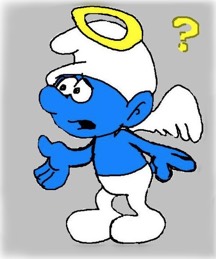
�
